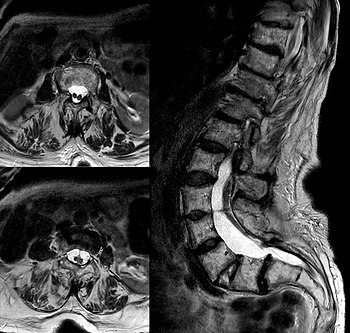| Diastematomyelia | |
|---|---|
 | |
| Diastematomelia in MRI of lumbar spine. | |
| Specialty | Neurology |
In neurology, diastematomyelia (occasionally diastomyelia) is a congenital disorder in which a part of the spinal cord is split, usually at the level of the upper lumbar vertebra in the longitudinal (sagittal) direction. Females are affected much more commonly than males. This condition occurs in the presence of an osseous, cartilaginous or fibrous septum in the central portion of the spinal canal which then produces a complete or incomplete sagittal division of the spinal cord into two hemicords. When the split does not reunite distally to the spur, the condition is referred to as diplomyelia, which is true duplication of the spinal cord.[1][additional citation(s) needed]
- ^ Doherty, D.; Walker, W. O. (1 January 2014). "Neural Tube Defects". Encyclopedia of the Neurological Sciences (Second ed.). Academic Press. pp. 360–365. ISBN 978-0-12-385158-1. Retrieved 28 February 2023.